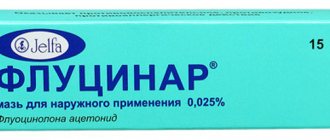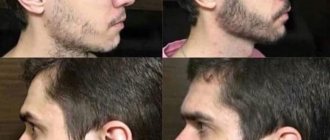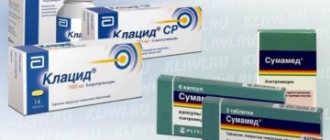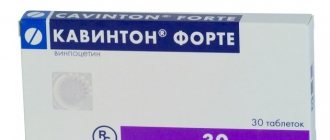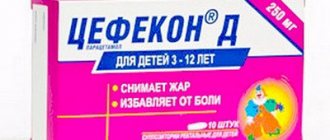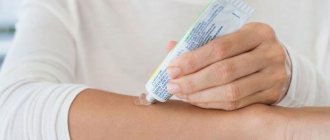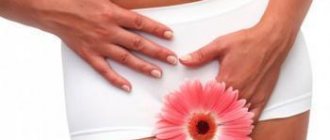Medicinal properties
Syntomycin liniment (mn chloramphenylcol 10%) is an antimicrobial drug that is used to treat various skin diseases. It has a pronounced bacteriostatic effect, due to which it can effectively suppress most strains of bacteria and microorganisms that provoke skin inflammation.
This antibiotic is aimed at eliminating boils, age spots and festering pimples. It also promotes skin healing from burns.
Suppositories of this drug are used to suppress infections in the genitourinary organs.
Sitomycin (synthomycin, Latin) is excreted by bile and kidneys within ten hours.
Syntomycin ointment - what is it?
Synthomycin ointment is an antibiotic whose intended purpose is to eliminate irritation, inflammation, burns and ulcers on the skin. The product looks like a white viscous substance of a yellowish tint with a specific odor.
There are 3 types of ointment, differing in the degree of concentration of the main component - 1, 5, 10%. The latter is most often used to treat deep and severe skin lesions (wounds or burns). To combat acne, it is recommended to use the second option (5%), it is this concentration and the presence of additional components that have the following effects on the skin:
- chloramphenicol (synthomycin) – effect on pathogenic microflora;
- castor oil - reduces inflammation, redness, itching, brightens and evens out facial tone;
- distilled water with an emulsifier - cleanses the skin;
- novocaine - provides a mild analgesic effect.
Syntomycin has a mild but intense therapeutic effect, eliminating most bacteria and viruses, and fatty castor oil “works” on the appearance - soothes the skin, does not dry it out, but nourishes and restores it.
The antibiotic contained in synthomycin solves two problems: it fights microbes and relieves inflammation.
Indications for use
Synthomycin liniment is used to treat the following diseases and conditions:
- Second and third degree burns
- Acute hemorrhoids
- Post-acne and pimples caused by allergies
- When pigment spots form
- Against purulent acne
- For wound infection
- Against soft tissue necrosis
- For the treatment of cracked nipples during breastfeeding (only 5% cream is used)
- Trachoma
- For the treatment of boils
- Sycosis.
Also, this antibiotic in the form of suppositories helps in gynecology. Suppositories are used against genital infections (cystitis, urethritis).
Please note that if blood appears in the urine due to cystitis, then Syntomycin may no longer help. You can learn more about the causes and methods of treating this deviation in the article: urine mixed with blood in cystitis.
The average price is from 40 to 100 rubles.
pharmachologic effect
Sintomycin has a powerful antibiotic effect. It affects the process of formation of protein structures directly inside the bacterial cell, while reducing the speed of movement to the links of lipid chains of amino acids, which causes a disruption in protein synthesis.
Shows activity against pathogens of purulent, meningococcal infections and intestinal bacteria resistant to sulfonamides, streptomycin, penicillin. Syntomycin is not intended to suppress protozoan microorganisms, acid-fast bacteria, anaerobic bacteria, fungi, and certain strains of staphylococci.
Sintomycin, suppositories
Sintomycin vaginal suppositories. The candles are packed in sealed cell packaging. They can be from white to yellow. They have a slight specific smell.
Cost: from 89 rub.
Mode of application
Suppositories should be administered intravaginally (1 suppository three times a day). Before the procedure, it is advisable to hygienically wash the genital organ with soapy water. The suppository is inserted deep into the vagina, after which the person must lie on his back until it is completely dissolved (up to thirty minutes). The duration of therapy is ten days. If necessary, the attending physician can extend treatment up to fourteen days.
The average price is from 30 to 90 rubles.
Synthomycin liniment 10% (5%)
Liniment contains 10% (rarely 5%) chloramphenicol. Can be from white to light yellow. The aluminum tube contains 25 g of the drug.
Mode of application
Synthomycin liniment is used externally after surgical treatment. A small amount of medicine is applied to the surface of the wound, after which a dry sterile bandage is applied on top. You need to apply the drug up to three times a day (depending on the degree of damage and the speed of wound healing). The duration of treatment is from five to ten days.
The product is also applied in a thin layer against acne, boils and hemorrhoids. A bandage is applied only when the wound is deep and infection can get there (this is determined by the attending doctor).
Release form and composition
Sintomycin is available in the following dosage forms:
- Liniment 10%: slightly yellowish or white, with a weak peculiar odor (25, 35 g in aluminum tubes, 1 tube in a cardboard box; 25, 40, 50 g in dark glass jars, 1 can in a cardboard box) ;
- Vaginal suppositories (5 pcs. in blister packs, 2 packs in a cardboard box).
The composition of 100 g of liniment includes:
- Active substance: chloramphenicol (D,L) – 10 g;
- Auxiliary components: emulsifier No. 1, castor bean seed oil, carmellose sodium 70/450 "O", sorbic acid, purified water.
1 suppository contains:
- Active substance: chloramphenicol – 0.25 g;
- Auxiliary components: vitepsol (in sufficient quantity to obtain a suppository weighing 1.71-1.89 g).
Contraindications
Suppositories and ointment of this drug at a concentration of 10% are contraindicated in the following cases:
- Individual intolerance to the active substance of the drug
- Tendency to bleed
- Porphyria
- Lack of glucose
- Acute liver failure
- Severe kidney disease
- Eczema, dermatitis
- Cancerous spots on the skin
- Psoriasis
- Fungal infections
- Age up to six months.
During pregnancy and breastfeeding
It is not recommended to use this drug during pregnancy, since there is no data on the safety of the effect of the active substance of the drug on the fetus. During breastfeeding, liniment can be used to treat cracked nipples, but only under the supervision of a doctor.
Directions for use and doses
Syntomycin is indicated for external use, applied topically to the affected areas by applying a sterile bandage or gauze bandage. Immediately before use, the affected area of skin is treated and dried. After two to three days, the bandages are changed, and drug therapy is carried out until healing.
Typically, a therapeutic effect is expected on the 2-3rd day of using the drug; if it is absent, a doctor’s consultation is necessary.
Side effects
Topical use of chloramphenicol may cause the following side effects:
- Irritation, itching and rash on the skin
- Hives
- Increasing suppuration of acne
- Allergic red spots
- Angioedema.
In the hematopoietic system:
- Leukopenia
- Thrombocytopenia
- Anemia
- Agranulocytosis
- Erythropenia
- Festering boils
- Granulocytosis.
This antibiotic, when used in gynecology, can cause the following side effects:
- Itching and burning when urinating
- Pain in the genital area
- Decreased body temperature.
Analogs
This drug has the following medicinal analogues:
“Levomekol”
Nizhpharm, Russia. Price from 123 to 150 rubles.
Main action: levomekol has a pronounced antibacterial effect. Composition: levomekol (1 g) contains 0.75 g of chloramphenicol.
pros
- The ointment helps with hemorrhoids and after burns
- Helps get rid of acne of various origins and boils
Minuses
- May cause allergic reactions
- It has only one release form.
“Levomycetin”
LECCO, Russia. Price from 14 to 340 rubles.
Main action: antibacterial, bactericidal, healing. Release form: alcohol solution, tablets, powder for solution for injection.
pros
- Tablets and solution are effective for the treatment of boils, acne, bedsores and trophic ulcers
- It has many release forms - you can choose a more convenient one
Minuses
- Tablets are contraindicated for eczema and psoriasis
- May cause skin rash.
“Bioparox”
Forest Laboratoris, France. Price from 480 to 520 rubles.
Main action: antiseptic, healing. Ingredients: fusafungine (active substance). Release form: aerosol for external use.
pros
- Effective for treating acne and boils
- Can be used by children from three years old
Minuses
- Unpleasant taste and smell
- May cause various side effects in the nervous and digestive systems.
“Hexicon”
Nizhpharm, Russia Price from 50 to 300 rub.
Main action: antiseptic, antimicrobial. Ingredients: chlorhexidine (active substance). Release form: white-yellow suppositories for intravaginal use.
pros
- Over-the-counter release
- Can be used during lactation and pregnant women
Minuses
- Spark plugs may leak and may not stay in the area of application.
- The likelihood of itching in the genital area and burning sensation when urinating.
Instructions for use
The drug should be stored in a cool, dry and dark place for 2 years from the date of manufacture. The optimal storage temperature is 15ºС. It is important that the place is inaccessible to children.
When applying, do not allow the drug to come into contact with the eyes. Syntomycin should not be used to treat wounds at the stage of regeneration, that is, healing. It is not recommended to use it for those who have previously received radiation treatment or taken cytotoxic drugs. When liniment is applied to a large surface area, a disulfiram-like reaction may develop, accompanied by coughing, vomiting, nausea, rapid heartbeat, etc.
You can purchase the drug at any pharmacy without a doctor's prescription. The price of the drug is not high - 30 rubles for a 25 ml tube.
Reviews about the drug liniment syntomycin are very contradictory. Among the positive qualities of the drug, one can note its low cost and effectiveness, especially for the treatment of acne. However, the risk of side effects and limited use (pregnancy, lactation, children in the first years of life) make it not the most convenient.
Currently, synthomycin is still known and widely used, but is largely considered “obsolete”. New, more effective and safe drugs are gradually being developed.
Instructions for use of synthomycin ointment must be strictly followed. If the dose of the drug is significantly exceeded, it will negatively affect the human condition - the point is its toxic effect.
Before you begin to treat fistula tracts and purulent cavities, you need to perform surgical treatment. If this is not done, then the liniment will not be able to penetrate into the deep layers of tissue to have the desired effect there. After the cavities are cleaned, they should be loosely filled with tampons soaked in ointment.
Reviews of the use of syntomycin ointment from both doctors and patients are clearly positive. But this is the case if the prescription and treatment process is controlled by a doctor. Syntomycin liniment is an excellent medicine that should be in the medicine cabinet in every home. In many cases, the use of ointment is part of complex therapy.
Synthomycin liniment analogues also belong to antibiotic ointments. The most basic and well-known are “Levosin” and “Levomekol”. It is advisable to first consult with your doctor before replacing the ointment with an analogue.
Reviews from doctors and patients confirm that about 40 different diseases can be treated with this universal remedy. The article below will mention the most common pathologies. Most often, the ointment is prescribed for wounds in the healing stage, that is, in the absence of pus and dead tissue.
Liniment is also used to treat 2-3 degree burns, as well as for trophic ulcers. We immediately draw the reader’s attention to the fact that the product described is bacteriostatic. This means that it does not fight microbes, but stops their development, thus leaving the human body the opportunity to cope with them on its own.
Damage to the body by a microscopic subcutaneous mite (demodex) is a serious pathology in which the mite, embedded in the subcutaneous area, feeds on the produced fat and at the same time causes inflammation, accompanied by peeling of the skin, itching and redness. In this disease, syntomycin ointment dries out the skin, depriving the mite of nutrition, and promotes the healing of wounds left by this parasite.
The instructions for using liniment state that it is also used in the treatment of herpes zoster. Although the described drug is not an antiviral agent, it copes well with secondary infection, which occurs when lichen appears on the human body in places where blisters form. This is especially important for the elderly and children, since their immune systems are especially vulnerable.
Like all medications, the product described has its contraindications for use. And, before you start treatment, be sure to make sure that you do not belong to the group of people for whom using the ointment is dangerous. These are patients who have:
- blood diseases in which the process of hematopoiesis is disrupted;
- kidney and liver diseases;
- eczema;
- psoriasis;
- fungal skin infections;
- wounds with purulent and necrotic contents.
The ointment is not used during pregnancy and lactation, as well as for children in early infancy (up to 28 days). Liniment is prescribed with great caution to cancer patients, as well as to children under three years of age.
As you understood from the previous text, before using ointment for a child, you need to consult a doctor. Be sure to tell him if your baby has wounds from animal bites, large skin lesions, or severe burns. Don't forget to tell us about the little patient's reaction to antibiotics.
Synthomycin liniment is widely used in medical practice and generally has no side effects other than an allergic reaction to the components of this drug. True, those who use the ointment daily for a long time should also be careful: this can lead to impaired hematopoietic function.
And in the case when liniment is applied to a large area of skin, the patient should give up alcohol-containing drinks, since combining them with the specified drug can lead to convulsions and tachycardia. In addition, syntomycin ointment and any other product should not be used on the same area of skin.
Syntomycin ointment, in fact, is not an ointment. This name is erroneous; in fact, the drug is a liniment, a mixture of oil, liquid and emulsifiers.
Liniment differs from ointment in the composition of the base. Typically, the ointment contains 95-99% petroleum jelly and is a very greasy substance. Liniment contains oil diluted with water with the addition of chemical components.
Since many people are accustomed to calling this drug an ointment, we will also maintain the tradition and not violate generally accepted terminology.
The instructions for use of synthomycin ointment provide a list of diseases for which syntomycin is effective. Let's list what synthomycin ointment helps with and what it treats:
- Various infected wounds (injuries and burns, frostbite, accompanied by infection).
- Abscesses, pimples, boils, as well as hidradenitis - the formation of ulcers in the armpits.
The ointment is also used in the treatment of gynecological inflammation, hemorrhoids and cracked nipples in nursing women. Or more correctly, it was used in Soviet times, when there were no other treatment options. Today, there are a number of other external medications that are more effective in treatment and safer for an infant. Therefore, syntomycin is not prescribed for the treatment of breasts in a nursing woman.
Synthomycin ointment has found wide use in cosmetology due to its ability to dry inflamed skin. The effect of external use of the antibiotic becomes noticeable after 2-3 days. Thus, after a few days, redness decreases, pimples and ulcers dry out.
If there are only a few pimples, then the ointment is applied pointwise, to each pimple separately. If a large part of the facial skin is covered with acne, the ointment is applied in a continuous layer. For treatment, it is enough to smear your face with ointment 2 times a day (morning and evening).
For extensive rashes, make a mask of synthomycin, zinc and ichthyol ointment. The components are mixed in equal parts and applied to the face for 10-15, sometimes 20 minutes. After which it is washed off with water. This cosmetic procedure can get rid of severe acne in 10 days.
The use of syntomycin ointment for acne on the face in adolescents allows you to survive age-related rashes and do without their extensive manifestation on the face, neck, and neighboring areas of the skin.
And one more thing: synthomycin has a whitening effect. Therefore, it is added to facial skin whitening formulations. They also use synthomycin ointment for age spots.
In gynecology, syntomycin ointment is used to treat bacterial inflammation of the vagina and external genitalia, and for inflammatory processes on the cervix. For the treatment of vaginitis and vulvitis, syntomycin has a quick and effective effect, limits the spread of inflammation and removes infection.
Instructions for use in gynecology recommend introducing the ointment composition into the vagina using tampons. Before this, it is necessary to douche with an antiseptic solution (furatsilin or a decoction of antiseptic herbs - chamomile, sage).
And one more thing: treatment with antibacterial drugs can lead to vaginal candidiasis (thrush). Therefore, syntomycin ointment should be used when other means of fighting infection are ineffective.
Ointment with synthomycin helps reduce inflammation and swelling of the nasal mucosa during bacterial sinus infections - sinusitis, sinusitis, purulent runny nose. To do this, apply syntomycin ointment to the nose and blow your nose after 5-7 minutes. After which the ointment is reapplied.
Dina, Zaraysk When I was 12 years old, the first acne appeared, and my mother gave me syntomycin ointment. And she said “here’s a good remedy for acne.” Thanks to this remedy, I avoided many teenage torments associated with my appearance.
Ekaterina, Zhigulevsk For me, too, syntomycin ointment was a discovery. The pimples replaced each other constantly. Now there are much fewer of them, one might say almost none.
Tamara, Chelyabinsk The acne was so bad that they recommended a blood transfusion. I had almost decided to take this extreme measure, but then someone advised me to use syntomycin ointment as a miracle remedy. I studied the composition and decided to try it. I only applied it at night. And lo and behold! It helped me.
Gosha, Zapolyarny When I was a child, I was treated for a burn with syntomycin ointment. I was badly scalded with boiling water, the doctor told me to cover the wound with gauze and synthomycin. There were no other means then. That's how we were saved. It has healed without scars, only a small spot remains on the skin, it is a different shade of color in the place where there once was a burn.

